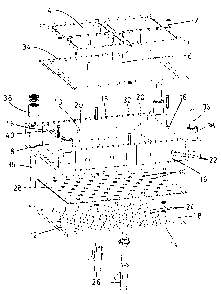Une partie des informations de ce site Web a été fournie par des sources externes. Le gouvernement du Canada n'assume aucune responsabilité concernant la précision, l'actualité ou la fiabilité des informations fournies par les sources externes. Les utilisateurs qui désirent employer cette information devraient consulter directement la source des informations. Le contenu fourni par les sources externes n'est pas assujetti aux exigences sur les langues officielles, la protection des renseignements personnels et l'accessibilité.
L'apparition de différences dans le texte et l'image des Revendications et de l'Abrégé dépend du moment auquel le document est publié. Les textes des Revendications et de l'Abrégé sont affichés :
| (12) Demande de brevet: | (11) CA 2351126 |
|---|---|
| (54) Titre français: | BOITE A VAPEUR POUR UTILISATION AVEC PRESSES VERTICALES ET HORIZONTALES ET METHODE D'UTILISATION CONNEXE |
| (54) Titre anglais: | STEAM CHEST FOR USE WITH VERTICAL AND HORIZONTAL PRESSES AND METHOD OF USE THEREOF |
| Statut: | Réputée abandonnée et au-delà du délai pour le rétablissement - en attente de la réponse à l’avis de communication rejetée |
| (51) Classification internationale des brevets (CIB): |
|
|---|---|
| (72) Inventeurs : |
|
| (73) Titulaires : |
|
| (71) Demandeurs : |
|
| (74) Agent: | DARYL W. SCHNURRSCHNURR, DARYL W. |
| (74) Co-agent: | |
| (45) Délivré: | |
| (22) Date de dépôt: | 2001-06-20 |
| (41) Mise à la disponibilité du public: | 2002-12-20 |
| Requête d'examen: | 2002-10-18 |
| Licence disponible: | S.O. |
| Cédé au domaine public: | S.O. |
| (25) Langue des documents déposés: | Anglais |
| Traité de coopération en matière de brevets (PCT): | Non |
|---|
| (30) Données de priorité de la demande: | S.O. |
|---|
A steam chest can be used with both a vertical press and a
horizontal press to manufacture foam prototypes in molding plates. The
steam chest has a frame that can accept tooling that has been manufactured
on a horizontal press or a vertical press. The same steam chest can be used
to produce foam prototypes of various shapes and sizes within a particular
size range. When the steam chest is used in a vertical press, the drainage
hole that extends downward is in an edge wall. When the steam chest is
used in a horizontal press, the drainage hole that extends downward is in a
side wall.
Note : Les revendications sont présentées dans la langue officielle dans laquelle elles ont été soumises.
Note : Les descriptions sont présentées dans la langue officielle dans laquelle elles ont été soumises.

2024-08-01 : Dans le cadre de la transition vers les Brevets de nouvelle génération (BNG), la base de données sur les brevets canadiens (BDBC) contient désormais un Historique d'événement plus détaillé, qui reproduit le Journal des événements de notre nouvelle solution interne.
Veuillez noter que les événements débutant par « Inactive : » se réfèrent à des événements qui ne sont plus utilisés dans notre nouvelle solution interne.
Pour une meilleure compréhension de l'état de la demande ou brevet qui figure sur cette page, la rubrique Mise en garde , et les descriptions de Brevet , Historique d'événement , Taxes périodiques et Historique des paiements devraient être consultées.
| Description | Date |
|---|---|
| Inactive : CIB de MCD | 2006-03-12 |
| Inactive : CIB de MCD | 2006-03-12 |
| Demande non rétablie avant l'échéance | 2005-06-20 |
| Le délai pour l'annulation est expiré | 2005-06-20 |
| Réputée abandonnée - omission de répondre à un avis sur les taxes pour le maintien en état | 2004-06-21 |
| Modification reçue - modification volontaire | 2003-04-25 |
| Modification reçue - modification volontaire | 2003-01-27 |
| Demande publiée (accessible au public) | 2002-12-20 |
| Inactive : Page couverture publiée | 2002-12-19 |
| Lettre envoyée | 2002-11-26 |
| Exigences pour une requête d'examen - jugée conforme | 2002-10-18 |
| Toutes les exigences pour l'examen - jugée conforme | 2002-10-18 |
| Requête d'examen reçue | 2002-10-18 |
| Inactive : CIB en 1re position | 2001-08-21 |
| Inactive : CCB attribuée | 2001-08-21 |
| Inactive : Certificat de dépôt - Sans RE (Anglais) | 2001-07-18 |
| Exigences de dépôt - jugé conforme | 2001-07-18 |
| Demande reçue - nationale ordinaire | 2001-07-18 |
| Date d'abandonnement | Raison | Date de rétablissement |
|---|---|---|
| 2004-06-21 |
Le dernier paiement a été reçu le 2003-05-26
Avis : Si le paiement en totalité n'a pas été reçu au plus tard à la date indiquée, une taxe supplémentaire peut être imposée, soit une des taxes suivantes :
Veuillez vous référer à la page web des taxes sur les brevets de l'OPIC pour voir tous les montants actuels des taxes.
| Type de taxes | Anniversaire | Échéance | Date payée |
|---|---|---|---|
| Taxe pour le dépôt - petite | 2001-06-20 | ||
| Requête d'examen - petite | 2002-10-18 | ||
| TM (demande, 2e anniv.) - petite | 02 | 2003-06-20 | 2003-05-26 |
Les titulaires actuels et antérieures au dossier sont affichés en ordre alphabétique.
| Titulaires actuels au dossier |
|---|
| WILLIAM R. POTTER |
| Titulaires antérieures au dossier |
|---|
| S.O. |